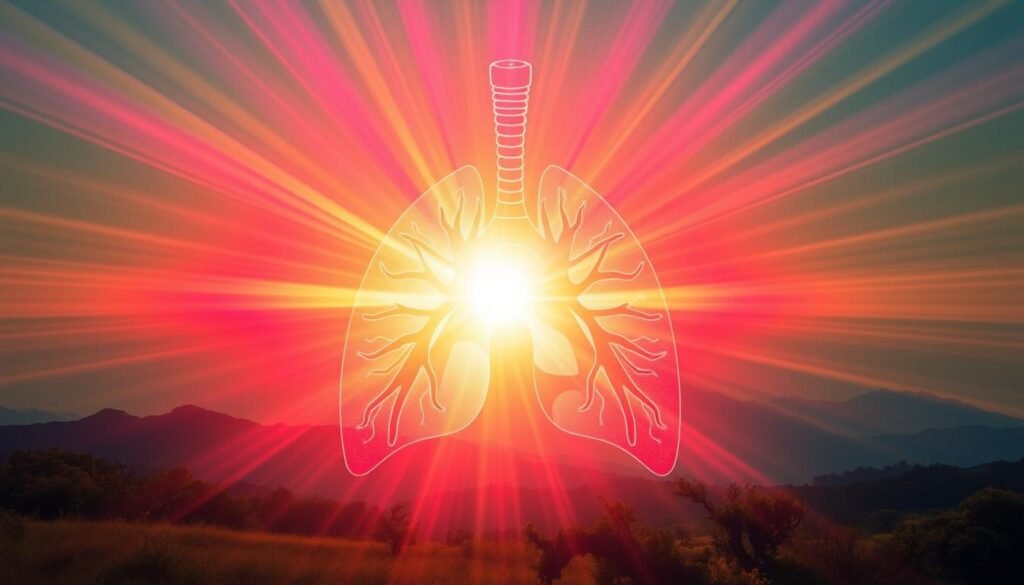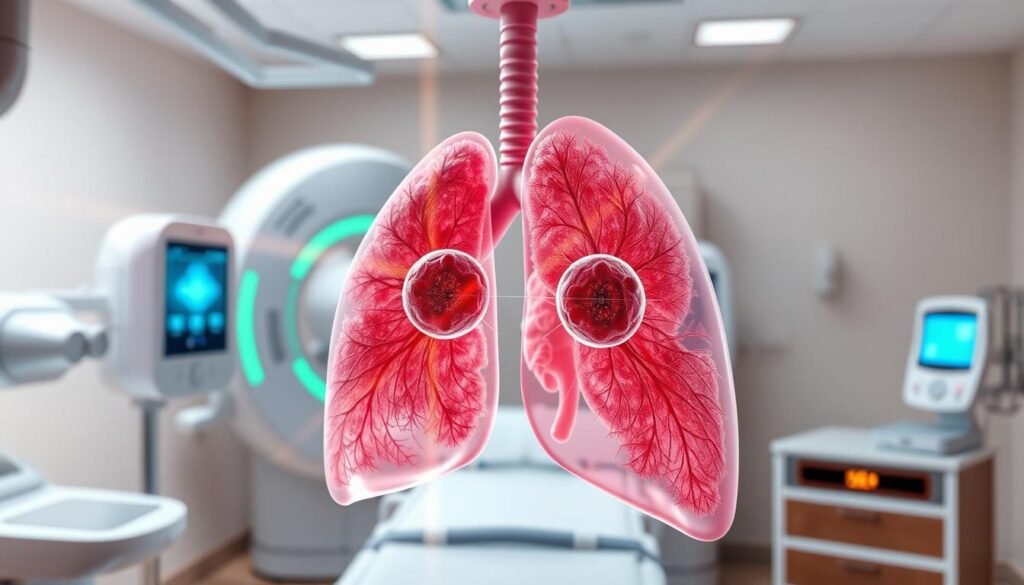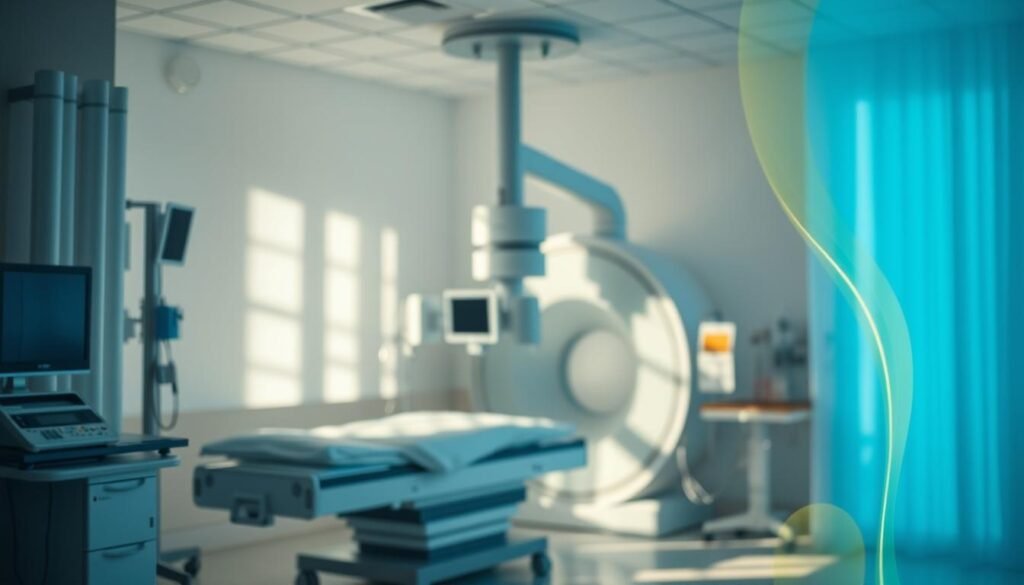Did you know 80% of lung cancer patients get radiation therapy? This fact shows how crucial radiation therapy is in battling lung cancer. Patients with lung cancer can choose from various treatments. Yet, radiation therapy is unique. It targets cancer cells without harming much of the healthy tissue around them.
This method not only aims to cure the cancer. It also helps relieve the painful symptoms that come with it. It’s important for patients and their families to understand how lung cancer radiation works. This knowledge is key when dealing with lung cancer.
Key Takeaways
- Radiation therapy is a common treatment for lung cancer patients, often utilized in combination with other therapies.
- External Beam Radiation Therapy (EBRT) is the most prevalent form, typically administered on an outpatient basis.
- Intensity-Modulated Radiation Therapy (IMRT) offers precision, improving outcomes by targeting tumor cells while sparing healthy tissue.
- Hypofractionated radiation therapy can significantly reduce treatment time, completing therapy in as little as 1½ weeks.
- The five-year survival rates for non-small cell lung cancer vary significantly by stage, showcasing the importance of timing and treatment methodologies.
Understanding Lung Cancer and Treatment Options
Lung cancer is mainly categorized into two types: non-small cell lung cancer (NSCLC) and small cell lung cancer (SCLC). Each type has unique characteristics and needs different treatments. Knowing the cancer type, its stage, and the patient’s health is key in choosing treatments.
Treatments for lung cancer include surgery, chemotherapy, and radiation therapy. Each plays a specific role in treating the disease. Radiation therapy, for example, can be the main treatment, help after surgery, or shrink tumors before surgery.
It’s vital for patients and families to understand treatment options. The choice of treatment depends on the tumor’s size, location, and the patient’s health. Here’s a simple guide to the common treatments:
| Type of Treatment | Description | Usage |
|---|---|---|
| Surgery | Removes the tumor and surrounding tissue. | Typically for early-stage lung cancer. |
| Chemotherapy | Uses drugs to kill cancer cells. | Often for advanced lung cancer stages or as adjuvant therapy. |
| Radiation Therapy | Kills cancer cells using high-energy rays. | Utilized in various capacities including curative and palliative care. |
Making the right choice in lung cancer treatments helps patients take control of their health. A thorough understanding leads to better talks with doctors. This ensures choices fit the patient’s needs and situation.
What is Radiation Therapy?
Radiation therapy uses high-energy rays or particles to attack lung cancer. It targets cancer cells and tries to spare healthy ones. As a treatment, it can be the main approach, used alongside chemotherapy, or to ease symptoms.
Definition and Purpose of Radiation Therapy
The aim of lung cancer radiation is to slow tumor growth and reduce pain. By focusing on cancer areas, doctors can shrink tumors and better the patient’s life. They make precise plans based on the cancer’s stage and patient health.
Types of Radiation Used in Lung Cancer Treatment
There are different types of radiation for treating lung cancer. The most common ones include:
- External Beam Radiation Therapy (EBRT): This directs energy beams at the tumor from outside. Treatments usually last six weeks.
- Stereotactic Body Radiation Therapy (SBRT): This delivers high doses over one to ten sessions. Technologies like TrueBeam™ and CyberKnife® are used.
- Intensity Modulated Radiation Therapy (IMRT): This advanced method varies doses while safeguarding healthy tissue.
- Brachytherapy: This places radioactive sources close to the tumor for intense targeting.
Other techniques like respiratory gating watch and adjust for tumor movement during breaths. RapidArc can quickly give IMRT in two minutes, improving precision and efficacy.
Overview of Radiation Therapy for Lung Cancer
Radiation therapy is key for treating lung cancer. It targets cancer cells while protecting healthy tissue. Patients who understand how it works can make better choices about their treatment.
How Radiation Therapy Works
Radiation therapy uses high-energy beams aimed at tumors. This stops cancer cells from growing. There are different methods, such as:
- Three-dimensional conformal radiation therapy: Shapes radiation beams to fit the tumor precisely.
- Intensity-modulated radiation therapy: Adjusts beam strength to protect healthy tissue.
- Stereotactic body radiation therapy: Offers high doses over a few days for small tumors, good for those who can’t have surgery.
- Brachytherapy: Puts radiation right into the airway if cancer blocks it.
Treatment usually happens daily for five days over several weeks. This helps lessen side effects. Most people feel better within two months.
When Radiation Therapy is Recommended
Doctors may suggest radiation at different times, based on what the patient needs. It’s very versatile:
- It’s a main treatment if surgery isn’t possible.
- It can be used after surgery to remove any leftover cancer cells.
- Before surgery, it can shrink tumors to make them easier to remove.
- It can help ease symptoms in late-stage lung cancer.
For small cell lung cancer, doctors might use radiation to keep cancer from spreading to the brain. After treatment, patients need to check in with their doctor to handle any long-term side effects.
| Type of Radiation Therapy | Description | Typical Use |
|---|---|---|
| Three-dimensional conformal radiation therapy | Delivers tailored radiation beams to tumors | Non-small cell lung cancers |
| Intensity-modulated radiation therapy | Adjusts strength of beams to spare healthy tissue | Various lung cancer types |
| Stereotactic body radiation therapy | Delivers high doses in a short period | Small tumors, patients unable to have surgery |
| Brachytherapy | Places radiation directly into the airway | Obstructing tumors |
Benefits of Radiation Therapy for Lung Cancer Treatment
Radiation therapy offers key advantages for those fighting lung cancer. It’s important to know how this treatment helps with lung cancer prognosis and overall well-being.
Improvement in Prognosis
Radiation therapy can improve the outlook for lung cancer patients. It can shrink tumors and attack cancer in specific areas. This boosts survival chances at many stages. It’s especially good for patients who can’t have surgery.
Methods like external beam radiation and stereotactic body radiation therapy are used. They can make it possible to have surgery by shrinking tumors first.
Symptom Relief and Quality of Life
Radiation therapy is key in managing lung cancer symptoms. It helps reduce pain, airway blockage, and bleeding. This improves life quality. For those with advanced lung cancer, it brings relief from tough symptoms.
This part of treatment boosts comfort and offers emotional support. It helps patients deal with cancer treatment’s hurdles.

Radiation Therapy Techniques for Lung Cancer
Knowing about different radiation therapy techniques is key for lung cancer care. These methods aim at the tumors accurately. They also protect the healthy tissue around them. Here are the main techniques used in treating lung cancer.
External Beam Radiation Therapy (EBRT)
External beam radiation therapy is most common in lung cancer care. It uses a machine called a linear accelerator to send radiation right to the tumor. Patients usually get this treatment five days a week for a few weeks. This helps target the cancer cells efficiently.
Brachytherapy and Internal Radiation
Brachytherapy puts radioactive material close to or inside the tumor. This method is good for tumors blocking air passages. It does a great job of saving healthy tissues. Many times, patients feel better fast, even though they might need to stay in the hospital for a little while.
Proton Therapy Overview
Proton therapy is a new way to fight lung cancer with protons, not traditional x-rays. It’s very precise, so it doesn’t harm nearby organs and tissues. It’s especially good for late-stage lung cancer. But, not all places offer it yet. Still, it’s a promising choice because it protects healthy tissue.
To learn more about radiation therapy options like EBRT and brachytherapy, check out this resource. Knowing these advanced techniques helps with planning treatment and can improve outcomes for patients.
Treatment Planning: What to Expect
Radiation therapy planning is key in treating lung cancer. Before treatment begins, a detailed simulation session is done. This session focuses on exact positioning and advanced imaging to design the treatment plan. It’s crucial for hitting the tumor accurately, which makes the treatment more effective.
Simulation and Treatment Strategy Development
During the simulation for lung cancer, specialists use advanced imaging to see where the tumor is. This is important for creating a treatment plan that fits the patient perfectly. They might mark the skin to keep the same position for all therapy sessions.
Positional Tools for Accurate Delivery
There are several tools used to boost how well radiation is delivered. These can include:
- Immobilizers: Devices that keep patients still, ensuring radiation hits the same spot every time.
- Custom Molds: Molds that hold the patient’s body in the correct position.
- Advanced Treatment Planning Systems: Software that makes sure the radiation dose is spread out just right. This helps to minimize harm to healthy lung areas while focusing on the tumor.
Using these tools in planning radiation therapy makes lung cancer treatment more successful. It ensures the radiation targets only the tumor, sparing healthy tissue around it. This approach can lead to better outcomes for patients.

Radiation Therapy Guidelines and Protocols
Radiation therapy for lung cancer uses radiation therapy guidelines. These enhance effectiveness and safety in treatment. Guidelines are based on research and clinical findings. They ensure treatments are consistent and effective.
Standard Procedures for Treatment
Following guidelines in lung cancer treatment is crucial. They include:
- Definitive thoracic radiation therapy for limited-stage small cell lung cancer (SCLC).
- Conditional recommendations for adjuvant radiation therapy in surgically resected cases.
- Utilizing external beam radiation therapy (EBRT) as the primary approach for most patients.
- Administration of prophylactic cranial irradiation for limited-stage SCLC to reduce brain metastasis risks.
| Treatment Type | Applicable Stage | Comments |
|---|---|---|
| Definitive Thoracic RT | Limited-stage SCLC | Recommended early administration enhances survival rates. |
| Adjuvant RT | Surgically resected lung cancer | Improves outcomes for patients with positive margins. |
| EBRT | All stages | Common treatment modality with evolving technologies. |
| Prophylactic Cranial Irradiation | Limited-stage SCLC | Reduces risk of brain metastases significantly. |
Innovative Techniques and Technologies
Recent innovations shape lung cancer treatment. Advancements include:
- Stereotactic body radiation therapy (SBRT) allows for high-dose radiation with fewer treatment sessions.
- Advanced imaging techniques enhance tumor targeting and minimize healthy tissue exposure.
- Intensity modulated radiation therapy (IMRT) and volumetric modulated arc therapy (VMAT) offer refined treatment delivery.
These lung cancer technologies have improved outcomes. They also reduce side effects from traditional treatments. The radiation therapy guidelines and tech keep getting better. For more, see the latest lung cancer research.
Managing Radiation Therapy Side Effects
Patients receiving radiation for lung cancer often face side effects. Knowing about these effects is key for good treatment and feeling well. This part talks about usual side effects and how to handle them. This helps in supporting lung cancer patients.
Common Side Effects Experienced
Side effects from radiation therapy depend on where you’re treated and your personal health. Some common side effects are:
- Fatigue: Many patients feel more tired as their treatment continues.
- Skin Irritation: The treatment area might get red, dry, and sensitive.
- Nausea and Vomiting: These can happen, especially if the belly is treated.
- Changes in Taste: Food might taste different to patients.
- Hair Loss: Hair may fall out in areas getting radiation, like the head or chest.
- Radiation Esophagitis: This is when the esophagus gets inflamed, causing heartburn and trouble swallowing.
Strategies for Side Effect Management
To handle side effects from radiation therapy, you need to plan and talk with your health care team. Some good strategies include:
- Dietary Adjustments: Eating soft foods can make eating less painful.
- Skin Care: Using gentle cleansers and moisturizers like aloe vera helps with skin problems.
- Fatigue Management: Light exercise and rest can help you feel less tired.
- Pain Management Techniques: Painkillers, either over-the-counter or prescribed, can offer relief.
- Open Communication: Talking about new or worsening symptoms with your doctor is important for getting help.

Quickly dealing with reactions from lung cancer treatment can really help improve a patient’s life. By handling these side effects well, patients can go through their treatment more easily and comfortably.
Long-term Effects of Radiation Therapy
Recovering from lung cancer treatment goes far past the end of radiation therapy. Many immediate side effects go away soon after treatment ends. Yet, the late side effects can show up over time, affecting health and life quality. Knowing about these long-term effects is key for ongoing care.
Understanding Late Side Effects
Late side effects might include lung fibrosis and changes in lung function. These issues can develop months or years after therapy ends. People who got higher radiation doses near their lung tissue face a bigger risk of lung problems later. It’s important to watch for these late effects in patients who had radiotherapy.
Follow-up Care and Monitoring
Follow-up care after lung cancer is crucial for keeping track of health. Regular visits help check if the therapy worked well. During these visits, doctors use imaging and exams to check lung function and look for cancer recurrence. Patients should stay on top of their health and follow their check-up schedule closely. For extra information on handling radiation side effects, check out this guide and learn more about treatment options.
Conclusion
Effective radiation therapy is key in fighting lung cancer. It helps control tumors and improves patients’ life quality. A deep look into lung cancer treatment shows that new techniques, like SBRT, have raised survival rates, especially in early-stage lung cancer.
Radiotherapy stands out in treatment, showing high success rates. Research shows it boosts survival chances compared to those who don’t get it. Over time, using radiation early on has proven to up the survival odds in advanced non-small cell lung cancer (NSCLC) cases. Today, one-third of NSCLC patients use radiotherapy, often with chemotherapy.
Understanding radiation and handling side effects lets patients choose their treatment wisely. By working with doctors, they explore treatments for better outcomes. For more on radiation therapy, check this detailed guide on SBRT’s treatment and effectiveness.